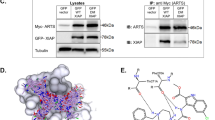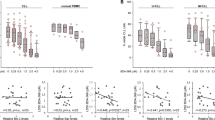Abstract
Inhibitor of apoptosis protein (IAP) suppresses apoptosis through binding and inhibiting active caspases-3, -7 and -9 via its baculoviral IAP repeat (BIR) domains. During apoptosis the caspase inhibition by IAPs can be negatively regulated by a mitochondrial protein second mitochondrial-derived activator of caspase (Smac). Smac physically interacts with multiple IAPs and relieves their inhibitory effect on caspases-3, -7 and -9. Recently, a small molecule Smac-mimic compound (Smac-mimic), which potentiates TNF-related apoptosis-inducing ligand (TRAIL) and tumor necrosis factor (TNF)-α mediated cell death in glioblastoma T98G cells and HeLa cells, was identified and characterized. To determine the efficacy of this compound in breast cancer cells, we first measured protein expression of three IAPs: XIAP, cIAP-1, and cIAP-2 in nine independent breast cancer cell lines. Three cell lines were chosen: a high IAPs expressing line MDA-MB-231, and two low IAPs expressing lines, T47D and MDA-MB-453. The cell lines were tested for their sensitivity to Smac-mimic alone or in combination with TRAIL or etoposide. Acting alone, Smac-mimic was quite potent with a cytotoxic IC50 of 3.8 nM in high IAPs expressing MDA-MB-231 cells, but was inactive at a much higher concentration in low IAPs expressing T47D and MDA-MB-453 cells. In fact, as low as 2.5 nM of Smac-mimic alone was sufficient to activate caspase-3 and induce apoptosis in MDA-MB-231 cells. In combinational treatments with TRAIL or etoposide, Smac-mimic significantly sensitized cells to growth suppression in MDA-MB-231 cells, but to a lesser extent in T47D and MDA-MB-453 cells. Furthermore, it significantly synergized MDA-MB-231, but not T47D cells to apoptosis induced by either TRAIL or etoposide. Thus, in these cell lines, Smac-mimic acts in an apparent IAPs dependent manner to induce apoptosis alone as well as sensitizes breast cancer cells to TRAIL or etoposide induced apoptosis via caspase-3 activation.
This is a preview of subscription content, access via your institution
Access options
Subscribe to this journal
Receive 50 print issues and online access
$259.00 per year
only $5.18 per issue
Buy this article
- Purchase on Springer Link
- Instant access to full article PDF
Prices may be subject to local taxes which are calculated during checkout





Similar content being viewed by others
Abbreviations
- BIR:
-
baculovirual IAP repeat
- IAPs:
-
inhibitors of apoptosis protein
- Smac:
-
second mitochondrial-derived activator of caspase
- TNF:
-
tumor necrosis factor
- TRAIL:
-
TNF-related apoptosis-inducing ligand
References
Arnt CR, Chiorean MV, Heldebrant MP, Gores GJ and Kaufmann SH . (2002). J. Biol. Chem., 277, 44236–44243.
Boyce M, Bryant KF, Jousse C, Long K, Harding HP, Scheuner D, Kaufman RJ, Ma D, Coen DM, Ron D and Yuan J . (2005). Science, 307, 935–939.
Cao C, Mu Y, Hallahan DE and Lu B . (2004). Oncogene, 23, 7047–7052.
Chai J, Du C, Wu JW, Kyin S, Wang X and Shi Y . (2000). Nature, 406, 855–862.
Chai J, Shiozaki E, Srinivasula SM, Wu Q, Dataa P, Alnemri ES and Shi Y . (2001). Cell, 104, 769–780.
Deveraux QL and Reed JC . (1999). Genes Dev., 13, 239–252.
Duan H, Wang Y, Aviram M, Swaroop M, Loo JA, Bian J, Tian Y, Mueller T, Bisgaier CL and Sun Y . (1999). Mol. Cell. Biol., 19, 3145–3155.
Earnshaw WC, Martins LM and Kaufmann SH . (1999). Ann. Rev. Biochem., 68, 383–424.
Fulda S, Wick W, Weller M and Debatin KM . (2002). Nat. Med., 8, 808–815.
Garber K . (2005). Nat. Biotechnol., 23, 409–411.
Hengartner MO . (2000). Nature, 407, 770–776.
Huang Y, Park YC, Rich RL, Segal D, Myszka DG and Wu H . (2001). Cell, 104, 781–790.
Kerr JF . (1971). J. Pathol., 105, 13–20.
Kerr JF, Wyllie AH and Currie AR . (1972). Br. J. Cancer, 26, 239–257.
Li L, Thomas RM, Suzuki H, De Brabander JK, Wang X and Harran PG . (2004). Science, 305, 1471–1474.
Lima RT, Martins LM, Guimaraes JE, Sambade C and Vasconcelos MH . (2004). Cancer Gene Ther., 11, 309–316.
Makin G and Hickman JA . (2000). Cell Tissue Res., 301, 143–152.
McManus DC, Lefebvre CA, Cherton-Horvat G, St-Jean M, Kandimalla ER, Agrawal S, Morris SJ, Durkin JP and Lacasse EC . (2004). Oncogene, 23, 8105–8117.
McNeish IA, Bell S, McKay T, Tenev T, Marani M and Lemoine NR . (2003). Exp. Cell Res., 286, 186–198.
Nguyen JT and Wells JA . (2003). Proc. Natl. Acad. Sci. USA, 100, 7533–7538.
Oost TK, Sun C, Armstrong RC, Al-Assaad AS, Betz SF, Deckwerth TL, Ding H, Elmore SW, Meadows RP, Olejniczak ET, Oleksijew A, Oltersdorf T, Rosenberg SH, Shoemaker AR, Tomaselli KJ, Zou H and Fesik SW . (2004). J. Med. Chem., 47, 4417–4426.
Pardo OE, Lesay A, Arcaro A, Lopes R, Ng BL, Warne PH, McNeish IA, Tetley TD, Lemoine NR, Mehmet H, Seckl MJ and Downward J . (2003). Mol. Cell. Biol., 23, 7600–7610.
Reed JC . (2003). Cancer Cell, 3, 17–22.
Riedl SJ, Renatus M, Schwarzenbacher R, Zhou Q, Sun C, Fesik SW, Liddington RC and Salvesen GS . (2001). Cell, 104, 791–800.
Salvesen GS and Duckett CS . (2002). Nat. Rev. Mol. Cell. Biol., 3, 401–410.
Scott FL, Denault JB, Riedl SJ, Shin H, Renatus M and Salvesen GS . (2005). EMBO J., 24, 645–655.
Srinivasula SM, Hegde R, Saleh A, Datta P, Shiozaki E, Chai J, Lee RA, Robbins PD, Fernandes-Alnemri T, Shi Y and Alnemri ES . (2001). Nature, 410, 112–116.
Sun C, Cai M, Gunasekera AH, Meadows RP, Wang H, Chen J, Zhang H, Wu W, Xu N, Ng SC and Fesik SW . (1999). Nature, 401, 818–822.
Sun Y, Bian J, Wang Y and Jacobs C . (1997). Oncogene, 14, 385–393.
Thompson CB . (1995). Science, 267, 1456–1462.
Wolf BB, Schuler M, Echeverri F and Green DR . (1999). J. Biol. Chem., 274, 30651–30656.
Wu G, Chai J, Suber TL, Wu JW, Du C, Wang X and Shi Y . (2000). Nature, 408, 1008–1012.
Wyllie AH . (1980). Nature, 284, 555–556.
Wyllie AH, Kerr JF and Currie AR . (1980). Int. Rev. Cytol., 68, 251–306.
Yang L, Cao Z, Yan H and Wood WC . (2003a). Cancer Res., 63, 6815–6824.
Yang L, Mashima T, Sato S, Mochizuki M, Sakamoto H, Yamori T, Oh-Hara T and Tsuruo T . (2003b). Cancer Res., 63, 831–837.
Yang YL and Li XM . (2000). Cell Res., 10, 169–177.
Acknowledgements
We thank Dr Xiaodong Wang at Howard Hughes Medical Institute and Department of Biochemistry, University of Texas Southwestern Medical Center for the Smac-mimic compound and Dr Stephen Ethier at Wayne State University for the breast cancer cell lines, SUM149, SUM102 and SUM52. This work is supported by DOD Breast Cancer Concept Award (BC032492) granted to YS.
Author information
Authors and Affiliations
Corresponding author
Rights and permissions
About this article
Cite this article
Bockbrader, K., Tan, M. & Sun, Y. A small molecule Smac-mimic compound induces apoptosis and sensitizes TRAIL- and etoposide-induced apoptosis in breast cancer cells. Oncogene 24, 7381–7388 (2005). https://doi.org/10.1038/sj.onc.1208888
Received:
Revised:
Accepted:
Published:
Issue Date:
DOI: https://doi.org/10.1038/sj.onc.1208888
Keywords
This article is cited by
-
Gold/alpha-lactalbumin nanoprobes for the imaging and treatment of breast cancer
Nature Biomedical Engineering (2020)
-
Eukaryotic initiation factor 5B (eIF5B) provides a critical cell survival switch to glioblastoma cells via regulation of apoptosis
Cell Death & Disease (2019)
-
Smac Gene Delivery by the Glycol Chitosan with Low Molecular Weight Polyethylenimine Induces Apoptosis of Cancer Cells for Combination Therapy with Etoposide
Macromolecular Research (2019)
-
Overcoming chemotherapy drug resistance by targeting inhibitors of apoptosis proteins (IAPs)
Apoptosis (2017)
-
Depletion of SAG/RBX2 E3 ubiquitin ligase suppresses prostate tumorigenesis via inactivation of the PI3K/AKT/mTOR axis
Molecular Cancer (2016)



